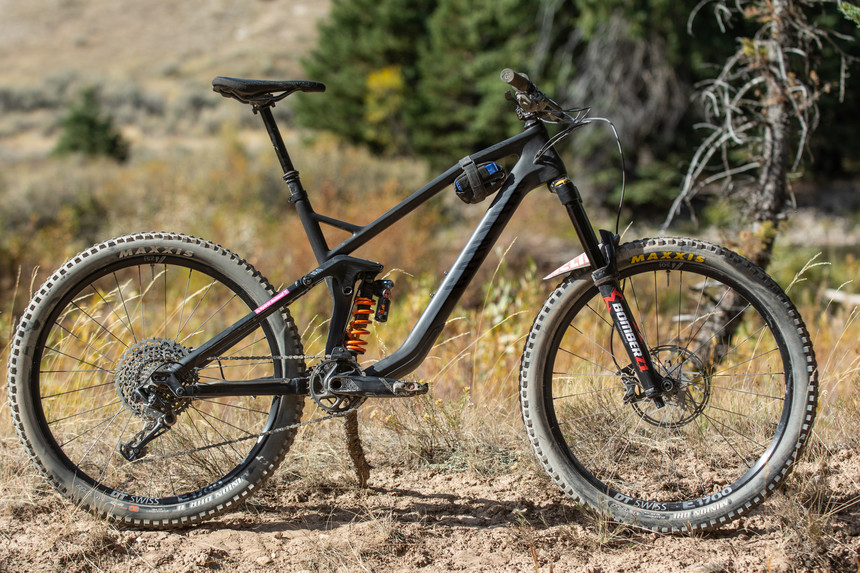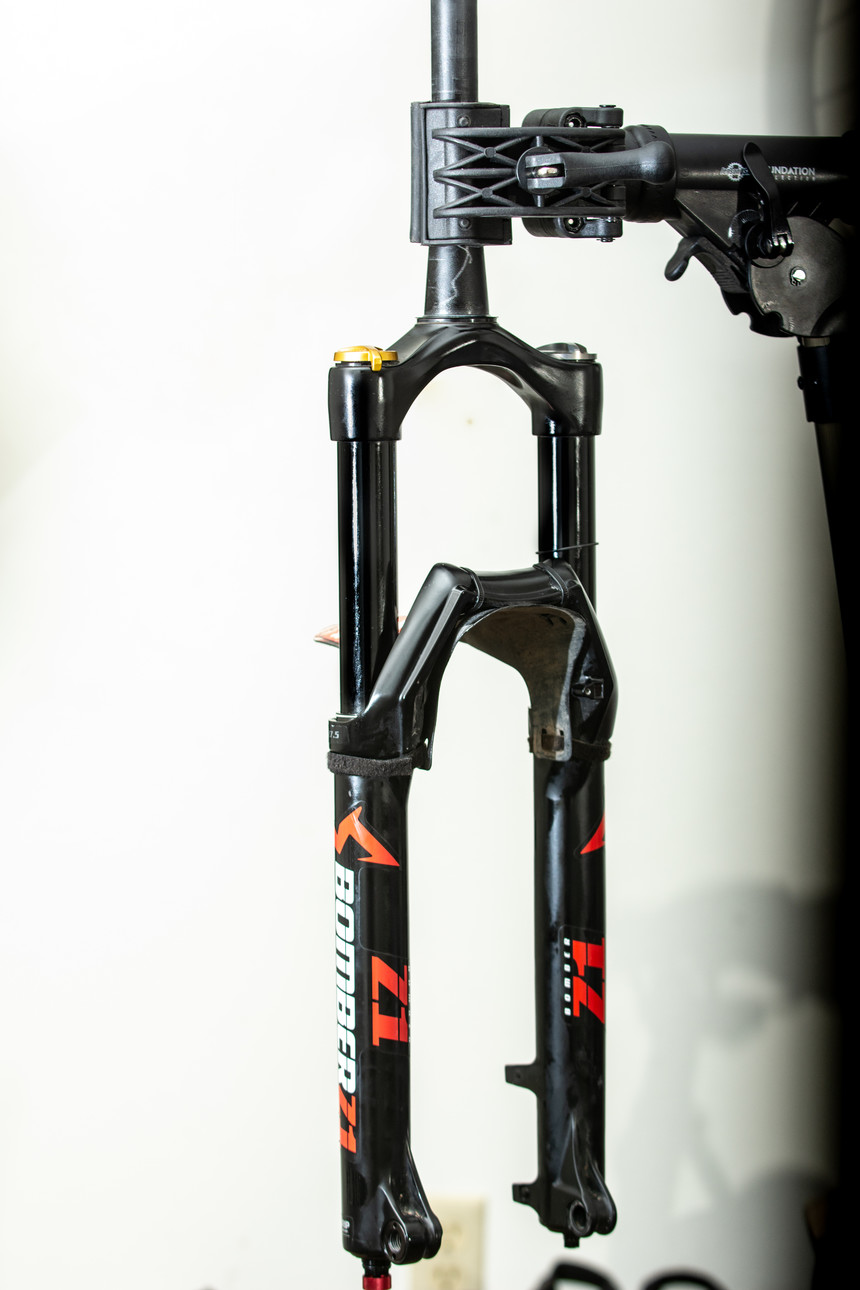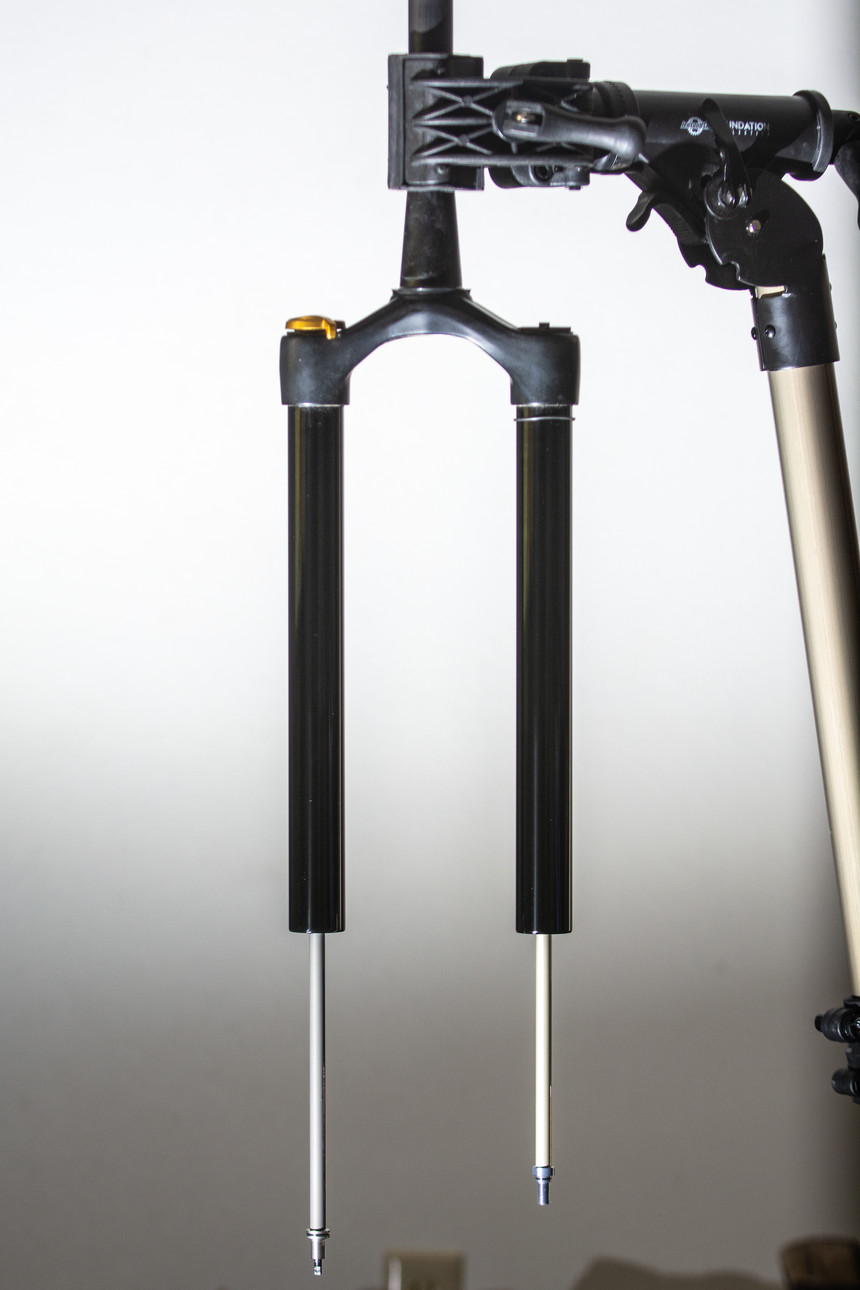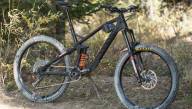 Stealthy bikes require stealthy forks. Marzocchi's Bomber returns as the Z1, and it's an impressive piece of suspension. Max Ritter photo.
Stealthy bikes require stealthy forks. Marzocchi's Bomber returns as the Z1, and it's an impressive piece of suspension. Max Ritter photo.
A few months ago, the internet blew up with the news that Marzocchi was back in the mountain bike game with two new suspension forks, the Bomber Z1 trail fork and the Bomber 58 DH fork. Recently, we've seen it under riders like Tyler McCaul, Geoff Gulevich, and Kaylee Gibb, to name a few. To be honest, I have never ridden any of the old Marzocchi stuff, no original Bombers, no 888s, no Monsters, but I certainly understand their place in mountain biking lore. Back then, they broke ground by putting outright performance above weight, and making products that re-defined freeride mountain biking. That being said, I went into this fork with an open mind, knowing fair and well that Marzocchi was employing Fox technology in their new forks, which was certainly a good thing, as Fox’s offerings have never been disappointing.
RELATED: Marzocchi is Back with A New Trail and DH Fork
I spend a lot of time on my bike, riding everything from Jackson Hole’s infamous Teton Pass jump and tech trails, racing enduros, pedaling long backcountry adventures in Idaho, to traveling to the Utah desert. In total, I have spent about 40 days on the new Bomber Z1, with a 170mm 27.5” version bolted to the front of my Canyon Strive CF. I did also spend a few days with the fork attached to an older Intense Tracer T275a. As the fork currently is not an OEM option with brands, I feel that this fork will see tons of use on older frames seeking an upgrade.
When I pulled the fork out the box, the first few things that came to mind were: wow this thing is beautiful, wow this thing is big, and wow this thing doesn’t weigh as much as I expected. The gold compression adjuster knob paired with the silver air top cap vibe very nicely with the all-black finish and trademark M-shaped crown. It looked like it was built strong, and ready to take a beating. Okay, enough on the looks, how does this thing actually perform?
 Marzocchi's Bomber Z1 features Fox's GRIP damper, offering rebound and high-speed compression adjustment, as well as the EVOL air spring for added small-bump compliance. Max Ritter photo.
Marzocchi's Bomber Z1 features Fox's GRIP damper, offering rebound and high-speed compression adjustment, as well as the EVOL air spring for added small-bump compliance. Max Ritter photo.
Installation was super-simple. It is worth noting that the Z1’s post mount is for an 180mm brake rotor, not 160mm, so you will likely need to buy a new adaptor depending on rotor size/what fork you are coming from. I came from the 160mm Pike RCT3, so had to find a different rotor adaptor. Secondly, the fork comes only with 110mm Boost spacing, so plan on finding a new wheel if its not Boost.
Once that was sorted out, it was time to air up the fork, set sag, and find where I liked my rebound and compression adjustments to sit. Perfect reason to take a few shuttle laps on Teton Pass, amirite? For the first few runs, the fork felt really harsh at the recommended pressure settings. In order to get enough small bump sensitivity, I had to run it at nearly 20 PSI lower than the neat little air pressure sticker said, so I contacted Marzocchi for an answer.
After a few back-and-forths with Marzocchi’s Matt Pacocha, we figured it out. I live at nearly 7,000 feet, and the Z1s are assembled and initially pressurized at around sea level. I had air in the lowers, and after doing the old zip-tie trick (insert a small zip tie between the stanchion and the seal) all was fixed. I re-inflated to 73 PSI (with 3 tokens) and the fork felt butter smooth.
The GRIP damper may not offer as much adjustability as the Fox’s new FIT GRIP 2, but it works damn well without those adjustments. With 23 clicks of rebound adjustment, and a full range of compression adjustment, the GRIP damper does exactly what it should: eat up bumps, smooth out trail chatter, and do all of that over a long period of time without fail. I typically found myself riding with the compression knob set at the 2 o’clock position and would turn it to 4 or 5 o’clock when climbing. Turning it all the way fully locks out the fork, which felt weird, even on paved roads, so I never used it.
The Z1’s chassis is stiff. Like, really stiff. With lowers made of 6000-series aluminum (slightly thicker than Fox’s 7000-series alloy), this thing isn’t moving in any ways it shouldn’t, and that’s a good thing.
So, what does that actually mean on the trail? Well, the fork is noticeably better at holding a line and plowing through rough terrain than anything I have ever ridden. In essence, it’s easier to ride rough trails because the front end of your bike isn’t bouncing off every rock in sight. That's a plus in my book.
 Maintenance on the fork is a straightforward affair; the process is identical to that of a new Fox 36. Max Ritter photo.
Maintenance on the fork is a straightforward affair; the process is identical to that of a new Fox 36. Max Ritter photo.
Comparing it to the direct competitors: Rockshox’s Lyrik and the Fox 36, let’s say there’s not much of a difference in performance, they just have unique trail feel. The 36 seems to ride higher in its travel and feels slightly less plush, (think tired hands after long days on chunky trails), and the 36 could better satisfy the rider who pumps and actively moves their bike rather than simply plowing. The Lyrik feels very similar to the Z1 in terms of damping, but the chassis is noticeably less stiff (the stiff Bomber is better at holding a line at high speed. Think: monster truck).
Service on the Bomber is a straightforward affair. The process for changing oil and seals in the lower legs is identical to that of a Fox 36, though keep in mind that the damper leg gets super light 5wt oil, and the air side gets regular Fox 20wt oil. Marzocchi recommends a lower leg service after roughly 40 hours of riding, but when pulling apart the lowers, my fork's oil and seals still looked nearly new even after rallying sloppy conditions for weeks. The whole process should take the experienced home mechanic no more than 30 minutes. What has yet to be tested is whether a Fox FIT GRIP 2 damper will actually fit in the damper-side leg. This would give the Z1 the same range of adjustment as a Factory 36, in a less expensive and arguably stiffer chassis.
In the end, it’s clear that this fork definitely has an intended purpose: going fast and blasting through technical terrain without any sort of hesitation, day in and day out. It’s not a fork for the weight weenie looking to put in massive miles on his trail bike, though it certainly did not slow me down uphill. Rather, this thing will put a smile on your face every time you drop into a DH trail, a gnarly desert rock garden, or lap your local jump line.
Some small things to note: the fork seems to have a longer axle to crown height than comparable forks, so expect your bike’s front end to raise slightly. Accessing the air chamber proved slightly difficult, as the top cap is hard to grip with a socket or adjustable wrench. Its soft material is prone to rounding, so be careful when swapping out volume spacers. Speaking of those volume spacers, they are special to Marzocchi’s narrower internal stanchion diameter, so they are not compatible with Fox’s 36 spacers without modification.










RogerDavid
October 31st, 2018
Thanks for sharing amazing article also check out my blog https://www.techztown.com/
Roger564648
November 18th, 2018
Thanks for Sharing Helful Article.and Also Like Your Website.if You Like Useful TechTips,How To,Gadget Reviews,Tips And Tricks,Cool Hacks,Alternatives And PC,Moblie Tips,Internet Tips And other Stuff You can Visit MYWEBSITE https://www.techztown.com/